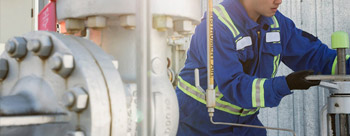- About Us
- Business Segment
CRANE Fluid Handling provides highly engineered products including valves, pumps, controls, and water treatment equipment for fluid handling applications worldwide.Payment and Merchandising Technologies is composed of two solution-providing segments that produce high quality, technologically advanced automatic merchandising equipment and payment systems.The Aerospace & Electronics segment combines the experience of nine long-time industry leaders to supply critical systems and components to the aerospace, defense and space markets.Crane Composites Inc., a subsidiary of Crane Co. (NYSE:CR), is the world's leading provider of fiber-reinforced composite materials.
- Asia Sourcing
- Media Center
- Careers
- Contact Us
Our History

“You can’t run a railroad or build a dam, operate a paper mill or lay a sewer, dig an oil well or heat a hospital, or launch a battleship or even take a shower without using one of the more than 40,000-odd products that are made by Crane Co.” — Fortune magazine, July 1936
This observation in the July 1936 issue of Fortune magazine summed up our company’s position well, and within ten years of that article, aviation and high speed flight were added to the list. Today, Crane innovation can be found behind the scenes virtually everywhere, helping everyday life run efficiently. Key events in the Company’s more than 150-year history are highlighted in the timeline below. You are invited to explore the chapters of our history in the pages of Crane: 150 Years Together.

1855
Founding of R.T. Crane Brass & Bell Foundry in Chicago. Crane produces valves, fittings, and specialty castings for a growing industrial America.
1860s
As Northwest Manufacturing Co., Crane supplies essential steam components to the railroads and enters the steam heating business. Crane Elevator Company begins making hoists, elevators and steam engines, becoming one of the major names in the field for 30 years.
1870s
Crane pioneers improvements in manufacturing, including the use of multiple purpose machines invented by R.T. Crane and a conveyor system of moving molds and pouring metal – the beginning of line production in foundries.
1880s
Crane’s business is booming. The company operates four manufacturing facilities and employs over 1500 people. Branch houses extend the company’s business to the Western U.S.
1885
Crane Co. is adopted as the Company name.
1890s
R.T. Crane establishes a metallurgical laboratory, probably the first in the Midwest.
Crane products have the strength and quality to meet the challenges of ever higher fluid pressures and temperatures.
1900
Crane produces steel valves and fittings in its own steel foundries.
Crane’s rigorous approaches to metallurgical science and material testing become the model for the valve and fitting industry.
1912
Founder R.T. Crane dies. Crane Co. is the leader in the valve and fitting business. R.T. Crane, Jr. shortly assumes the Company’s presidency.
The company builds the first truly modern factory, switching wholly to electricity for power. In Chicago, “The Great Works” built on 160 acres is the most modern factory of its time.
1920s
Crane Co. conceives the idea of the modern bathroom, creating the first practical decorative bathroom ensembles. The American bathroom becomes a sign of affluence and social pride. Crane plumbing fixtures, many designed by noted industrial designer Henry Dreyfuss, are celebrated for their styling, color and innovation.
1930
Company-owned branch distribution operations grow to 190 from only 86 in 1920. The highlight is the lavish $1 million showroom on the Atlantic City Boardwalk.
1936
CR listed on the New York Stock Exchange.
1937
The Golden Gate Bridge opens with its railing material supplied by Crane Co.
1942
To meet wartime demand, Crane increases steel valve output capacity four-fold to 25,000 tons annually. The U.S. Navy requires from 1,500 to 15,000 valves per ship.
1951
After the war, Crane supplies flow control products for aircraft. Hydro-Aire, a manufacturer of highly developed precision aircraft products is acquired.
1957
Crane introduces “Technical Paper 410”, building on the classic “Flow of Fluids” of 1942. Today, this quintessential guide to understanding the flow of fluids through valves, pipes and fittings is available as software.
1959
T.M. Evans elected Chairman and CEO. A new management philosophy moves Crane to streamline the distribution network and concentrate on industrial manufacturing.
1960s
Industrial expansion is furthered through domestic and international acquisitions such as Chapman Valve, Cochrane Corporation, Deming Company and Chempump.
1969
Crane pumps are on the moon. Hydro-Aire and Chempump pumps are used in the Gemini and Apollo Space programs.
1970s
Crane is well-positioned in four major areas of concentration: fluid and pollution control, steel, building products and aircraft/aerospace.
1980s
Crane exits the plumbing and plumbing distribution businesses in the U.S.
1981
Crane provides braking system for the first NASA space shuttle.
1984
R.S. Evans elected Chairman and CEO.
1990s
Evans leads Crane as a growth company with strong acquisition program in areas of fluid handling, engineered materials, merchandising systems, aerospace and controls.
2001
Eric C. Fast elected President and CEO. He continues strategic leadership of a collection of linked businesses to move Crane from a holding company to an operating company.
Early 2000s
Foundation for future profitable growth is laid with the implementation of new Operational Excellence tools, greater development of intellectual capital, strategic linkages and strong customer focus.
2005
Crane celebrates its 150th anniversary.
2013
Crane Co. completes the acquisition of MEI Conlux Holdings, the largest acquisition in the history of the company.
2014
Max H. Mitchell appointed President and CEO. He continues to execute on Crane’s longstanding strategy, moving the company further along its journey to an integrated operating company focused on three key global growth platforms: Fluid Handling, Aerospace & Electronics, and Crane Payment Innovations.






